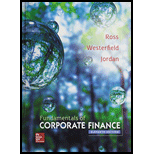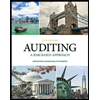
Fundamentals of Corporate Finance with Connect Access Card
11th Edition
ISBN: 9781259418952
Author: Stephen A. Ross Franco Modigliani Professor of Financial Economics Professor, Randolph W Westerfield Robert R. Dockson Deans Chair in Bus. Admin., Bradford D Jordan Professor
Publisher: McGraw-Hill Education
expand_more
expand_more
format_list_bulleted
Question
Chapter 2, Problem 5CRCT
Summary Introduction
To critically think about:The occurrence of negative shareholders’ equity with market values.
Introduction:
Market value refers to the value that the asset will fetch if it is sold in the open market. The firm records its assets at historical cost instead of the market value. Historical costs are lower than the market value. Hence, the value of liabilities sometimes exceeds the value of assets resulting in negative shareholders’ equity. However, there will be no negative shareholders equity when the market values are used.
Expert Solution & Answer
Want to see the full answer?
Check out a sample textbook solution
Students have asked these similar questions
if $500 is placed in an account that earns a normal 6 % compounded quarterly, what will be worith in 10 years.
a. $907
b. $1,045
c. $980
d. $ 1,020
e. $117.48
what is the approximate yield to maturity (YTM) of a bond that is currently selling for $1,150 in the market place ? the annual bond has 20 years remaining until maturity and pays a 14% coupon. (assume annual interest payments and discounting)
a. 14%
b. 7%
c. 6%
d. 12%
If blurr image please comment i will write values.
please dont Solve with incorrect values otherwise unhelpful.
Chapter 2 Solutions
Fundamentals of Corporate Finance with Connect Access Card
Ch. 2.1 - Prob. 2.1ACQCh. 2.1 - What is liquidity? Why is it important?Ch. 2.1 - What do we mean by financial leverage?Ch. 2.1 - Explain the difference between accounting value...Ch. 2.2 - What is the income statement equation?Ch. 2.2 - Prob. 2.2BCQCh. 2.2 - Why is accounting income not the same as cash...Ch. 2.3 - What is the difference between a marginal and an...Ch. 2.3 - Do the wealthiest corporations receive a tax break...Ch. 2.4 - Prob. 2.4ACQ
Ch. 2.4 - Prob. 2.4BCQCh. 2.4 - Why is interest paid not a component of operating...Ch. 2 - What types of accounts are the most liquid?Ch. 2 - What is an example of a noncash expense?Ch. 2 - The marginal tax rate is the tax rate which...Ch. 2 - Prob. 2.4CTFCh. 2 - Prob. 1CRCTCh. 2 - Accounting and Cash flows [LO2] Why might the...Ch. 2 - Prob. 3CRCTCh. 2 - Operating Cash Flow [LO2] In comparing accounting...Ch. 2 - Prob. 5CRCTCh. 2 - Cash Flow from Assets [LO4] Suppose a companys...Ch. 2 - Prob. 7CRCTCh. 2 - Net Working Capital and Capital Spending [LO4]...Ch. 2 - Prob. 9CRCTCh. 2 - Prob. 10CRCTCh. 2 - Prob. 11CRCTCh. 2 - Earnings Management [LO2] Companies often try to...Ch. 2 - Building a Balance Sheet [LO1] KCCO, Inc., has...Ch. 2 - Building an Income Statement [LO1] Billys...Ch. 2 - Dividends and Retained Earnings [LO1] Suppose the...Ch. 2 - Prob. 4QPCh. 2 - Calculating Taxes [LO3] The Dyrdek Co. had 267,000...Ch. 2 - Prob. 6QPCh. 2 - Calculating OCF [LO4] Ridiculousness, Inc., has...Ch. 2 - Calculating Net Capital Spending [LO4] Bowyer...Ch. 2 - Calculating Additions to NWC [LO4] The 2014...Ch. 2 - Cash Flow to Creditors [LO4] The 2014 balance...Ch. 2 - Cash Flow to Stockholders [LO4] The 2014 balance...Ch. 2 - Prob. 12QPCh. 2 - Market Values and Book Values [LO1] Klingon...Ch. 2 - Prob. 14QPCh. 2 - Using Income Statements [LO1] Given the following...Ch. 2 - Preparing a Balance Sheet [LO1] Prepare a 2015...Ch. 2 - Prob. 17QPCh. 2 - Prob. 18QPCh. 2 - Net Income and OCF [LO2] During 2014, Raines...Ch. 2 - Prob. 20QPCh. 2 - Prob. 21QPCh. 2 - Calculating Cash Flows [LO4] Consider the...Ch. 2 - Net Fixed Assets and Depreciation [LO4] On the...Ch. 2 - Prob. 24QPCh. 2 - Use the following information for Taco Swell,...Ch. 2 - Use the following information for Taco Swell,...Ch. 2 - Prob. 1MCh. 2 - Prob. 2M
Knowledge Booster
Similar questions
- Inferior Investment Alternatives Although investing requires the individual to bear risk, the risk can be controlled through the construction of diversified portfolios and by excluding any portfolio that offers an inferior return for a given amount of risk. While this concept seems obvious, one of your clients, Laura Spegele, is considering purchasing a stock that you believe will offer an inferior return for the risk she will bear. To convince her that the acquisition is not desirable, you want to demonstrate the trade-off between risk and return. While it is impractical to show the trade-off for all possible combinations, you believe that illustrating several combinations of risk and return and applying the same analysis to the specific investment should be persuasive in discouraging the purchase. Currently, U.S. Treasury bills offer 2.5 percent. Three possible stocks and their betas are as follows: 1. What will be the expected return and beta for each of the following portfolios? a.…arrow_forwardSolve this fin. Qn no aiarrow_forwardYou gave me unhelpful so i also gave you unhelpful.arrow_forward
- What is corporate finance? how many types of corporate finance??arrow_forwardEsfandairi Enterprises is considering a new three-year expansion project that requires an initial fixed asset investment of $2,350,000. The fixed asset will be depreciated straight-line to zero over its three-year tax life, after which time it will be worthless. The project is estimated to generate $3,310,000 in annual sales, with costs of $2,330,000. Assume the tax rate is 23 percent and the required return on the project is 11 percent. What is the project's NPV? Note: A negative answer should be indicated by a minus sign. Do not round intermediate calculations and round your answer to 2 decimal places, e.g., 32.16.arrow_forwardGyygvvv iiiedfarrow_forward
arrow_back_ios
SEE MORE QUESTIONS
arrow_forward_ios
Recommended textbooks for you
- Century 21 Accounting Multicolumn JournalAccountingISBN:9781337679503Author:GilbertsonPublisher:Cengage
- Business/Professional Ethics Directors/Executives...AccountingISBN:9781337485913Author:BROOKSPublisher:Cengage
 Auditing: A Risk Based-Approach (MindTap Course L...AccountingISBN:9781337619455Author:Karla M Johnstone, Audrey A. Gramling, Larry E. RittenbergPublisher:Cengage Learning
Auditing: A Risk Based-Approach (MindTap Course L...AccountingISBN:9781337619455Author:Karla M Johnstone, Audrey A. Gramling, Larry E. RittenbergPublisher:Cengage Learning

Century 21 Accounting Multicolumn Journal
Accounting
ISBN:9781337679503
Author:Gilbertson
Publisher:Cengage



Business/Professional Ethics Directors/Executives...
Accounting
ISBN:9781337485913
Author:BROOKS
Publisher:Cengage


Auditing: A Risk Based-Approach (MindTap Course L...
Accounting
ISBN:9781337619455
Author:Karla M Johnstone, Audrey A. Gramling, Larry E. Rittenberg
Publisher:Cengage Learning